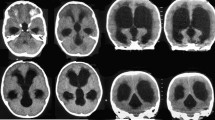Abstract
Background
Intraparenchymal cavities communicating with the ventricles may appear in patients with chronic obstructive hydrocephalus despite no identifiable surgerical, vascular or traumatic causes. The rate, features, pathogenesis, evolution and clinical impact of intraparenchymal diverticula have not been outlined, yet.
Methods
Brain MRIs of 130 patients (mean age: 11.3 years; age range: 0–67; 60 females) with chronic obstructive hydrocephalus were analyzed. The pathogenesis, neurosurgical treatment, ventricle size, signs of transependymal reabsorption and septum pellucidum integrity of the hydrocephalus were recorded. Subarachnoid outpouching of the ventricles, post-hemorrhagic parenchymal cavities, paths of ventricular shunting and cavities not communicating with the ventricles were excluded. Of patients with intraparenchymal diverticula, all previous available CT and MRI scans were evaluated.
Results
Eight patients (6.2 %, mean age: 18.7 years; age range: 2–42) harbored 11 intraparenchymal diverticula sprouting from the temporal (6), occipital (3) or frontal (2) horns of the lateral ventricles. Intraparenchymal diverticula were more frequent in males (p = 0.04) and older patients (18.7 ± 12.7 vs 11.3 ± 9.8 years, p = 0.04). Their presence or evolution (mean neuroradiological follow-up 3.6 years; range: 0–8) showed a trend of association with hydrocephalus severity (bifrontal index) and did not correlate with the surgical treatment. In three patients the diverticula progressed during follow-up. One patient presented with hemiparesis consistent with the intraparenchymal lesion and improved after ventricular shunting. A DTI study revealed that the cortico-spinal tract was partly included in the septum between the ventricle and the intraparenchymal diverticulum.
Conclusions
Clinicians dealing with chronic severe obstructive hydrocephalus should be aware of ventricular intraparenchymal diverticulation. Studies aiming at clarifying their pathogenesis and proper management are warranted.






Similar content being viewed by others
References
Abe M, Uchino A, Tsuji T, Tabuchi K (2003) Ventricular diverticula in obstructive hydrocephalus secondary to tumor growth. Neurosurgery 52:65–70, discussion 70–1
Adams RD (1975) Diverticulation of the cerebral ventricles: a cause of progressive focal encephalopathy. Dev Med Child Neurol 17(suppl):135–137
Ambarki K, Israelsson H, Wåhlin A, Birgander R, Eklund A, Malm J (2010) Brain ventricular size in healthy elderly: comparison between Evans index and volume measurement. Neurosurgery 67:94–99, discussion 99
Andresen M, Juhler M (2012) Multiloculated hydrocephalus: a review of current problems in classification and treatment. Childs Nerv Syst 28:357–362
Dinçer A, Özek MM (2011) Radiologic evaluation of pediatric hydrocephalus. Childs Nerv Syst 27:1543–1562
Huh JS, Hwang YS, Yoon SH, Cho KH, Shin YS (2007) Lateral ventricular diverticulum extending into supracerebellar cistern from unilateral obstruction of the foramen of monro in a neonate. Pediatr Neurosurg 43:115–120
Jabaudon D, Charest D, Porchet F (2003) Pathogenesis and diagnostic pitfalls of ventricular diverticula: case report and review of the literature. Neurosurgery 52:209–212
Karnaze MG, Shackelford GD, Abrarmson CL (1987) Atrial ventricular diverticulum: sonographic diagnosis. AJA 149:569–571
Kiefer M, Eymann R, von Tiling S, Müller A, Steudel WI, Booz KH (1998) The ependyma in chronic hydrocephalus. Childs Nerv Syst 14:263–270
Leahy WR, Singer HS (1977) Progressive focal deficit with porencephaly. Arch Neurol 34:154–156
Naidich TP, McLone DG, Hahn YS, Hanaway J (1982) Atrial diverticula in severe hydrocephalus. AJNR 3:257–266
Northfield DWC, Russel DS (1939) False diverticulum of a lateral ventricle causing hemiplegia in chronic internal hydrocephalus. Brain 62:311–320
Osuka S, Takano S, Enomoto T, Ishikawa E, Tsuboi K, Matsumura A (2007) Endoscopic observation of pathophysiology of ventricular diverticulum. Childs Nerv Syst 23:897–900
Penfield W (1929) Diencephalic autonomous epilepsy. Arch Neurol Psychiatry 22:358–374
Rizvi R, Anjum Q (2000) Hydrocephalus in children. J Pak Med Assoc 55:502–507
Sandberg DI (2008) Endoscopic management of hydrocephalus in pediatric patients: a review of indications, techniques, and outcomes. J Child Neurol 23:550–560
Sarnat HB (1995) Ependymal reactions to injury. A review. J Neuropathol Exp Neurol 54:1–15
Schrag M, McAuley G, Pomakian J, Jiffry A, Tung S, Mueller C, Vinters HV, Haacke EM, Holshouser B, Kido D, Kirsch WM (2010) Correlation of hypointensities in susceptibility-weighted images to tissue histology in dementia patients with cerebral amyloid angiopathy: a postmortem MRI study. Acta Neuropathol 119:291–302
Schroeder HW, Oertel J, Gaab MR (2007) Endoscopic treatment of cerebrospinal fluid pathway obstructions. Neurosurgery 60:ONS44–ONS51
Tardieu M, Evrard P, Lyon G (1981) Progressive expanding congenital porencephalies: a treatable cause of progressive encephalopathy. Pediatrics 68:198–202
Wakai S, Nagai M (1984) Ventricular diverticulum. J Neurol Neurosurg Psychiatry 47:514–517
Wong TT, Liang ML, Chen HH, Chang FC (2011) Hydrocephalus with brain tumors in children. Childs Nerv Syst 27:1723–1734
Conflicts of interest
The author(s) declare that they have no competing interests.
Author information
Authors and Affiliations
Corresponding author
Rights and permissions
About this article
Cite this article
Manara, R., Citton, V., Traverso, A. et al. Intraparenchymal ventricular diverticula in chronic obstructive hydrocephalus: prevalence, imaging features and evolution. Acta Neurochir 157, 1721–1730 (2015). https://doi.org/10.1007/s00701-015-2540-3
Received:
Accepted:
Published:
Issue Date:
DOI: https://doi.org/10.1007/s00701-015-2540-3




